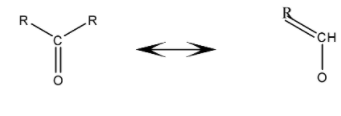
When propanal reacts with 2-methylpropanal in presence of $NaOH$, four different products are formed. The reaction is known as
(A) Aldol condensation
(B) Cross aldol condensation
(C) Cannizzaro reaction
(D) HVZ reaction
Answer
559.8k+ views
Hint: Whenever an aldehyde reacts with itself or some other aldehyde, in presence of $NaOH$, the reaction is aldol condensation. It can be cross aldol condensation if two different aldehydes react in the same reaction and in cross aldol condensation, four products are formed.
Complete step by step answer:
When two molecules of aldehyde containing $\alpha $- hydrogen or two molecules of ketones are reacted with aqueous or alcoholic alkali undergoes condensation reaction to give $\beta $- hydroxy aldehyde (aldol) or $\beta $- hydroxyl ketone (ketol).
And, when two different molecules of aldehydes or ketones are involved then such condensation is called crossed aldol condensation.
$\alpha $- hydrogen is the hydrogen atom attached to the $\alpha $- carbon i.e. the carbon atom next to the functional group.
The reaction between propanal and 2-methyl propanal is given as follows –
\[{C_2}{H_5}CHO + {C_3}{H_7}CHO\xrightarrow{{NaOH}}C{H_2}\left( {C{H_3}} \right)\left( {CHO} \right)CH\left( {OH} \right){C_2}{H_5} + C{\left( {C{H_3}} \right)_2}\left( {CHO} \right)CH\left( {OH} \right)CH{\left( {C{H_3}} \right)_2}\]\[ + CH{\left( {C{H_3}} \right)_2}\left( {CHO} \right)CH\left( {OH} \right){C_2}{H_5} + C{H_2}\left( {C{H_3}} \right)\left( {CHO} \right)CH\left( {OH} \right)CH{\left( {C{H_3}} \right)_2}\]
Here , the 4 products are 2-Methyl-3-hydroxypentanal , 2,2,4-Trimethyl-3-hydroxypentanal ,
2,2-Dimethyl-3-hydroxypentanal , 2,4-Dimethyl-3-hydroxypentanal .
Among these, the two products formed are due to aldol condensation between the same aldehyde and the other two due to aldol condensation between different aldehydes.
Now we consider the reactions between the aldehydes forming 4 different products.
Let's denote propanal as ${A_1}$ and 2-methyl propanal as ${A_2}$
${A_1} \to {A_1}$
${C_2}{H_5}CHO + {C_2}{H_5}CHO \to C{H_2}\left( {C{H_3}} \right)\left( {CHO} \right)CH\left( {OH} \right){C_2}{H_5}$
${A_2} \to {A_2}$
${C_3}{H_7}CHO + {C_3}{H_7}CHO \to C{\left( {C{H_3}} \right)_2}\left( {CHO} \right)CH\left( {OH} \right)CH{\left( {C{H_3}} \right)_2}$
${A_1} \to {A_2}$
${C_2}{H_5}CHO + {C_3}{H_7}CHO \to CH{\left( {C{H_3}} \right)_2}\left( {CHO} \right)CH\left( {OH} \right){C_2}{H_5}$
${A_2} \to {A_1}$
${C_3}{H_7}CHO + {C_2}{H_5}CHO \to C{H_2}\left( {C{H_3}} \right)\left( {CHO} \right)CH\left( {OH} \right)CH{\left( {C{H_3}} \right)_2}$
When two molecules of aldehyde not containing $\alpha $- hydrogen is reacted with 50 $\% $ alkalies undergo oxidation-reduction disproportionate to give corresponding alcohols and salts of carboxylic acid. This reaction is called Cannizzaro's reaction.
But here, both the reactant molecules have $\alpha $- hydrogen, so Cannizzaro reaction is not possible.
Hence, the reaction is cross aldol condensation.
So, the correct answer is Option B .
Note: In the mechanism of aldol condensation, the second aldehyde molecule’s $\alpha $- hydrogen gets attached to the first aldehyde molecule’s $\beta $ hydrogen.
$\beta $-hydrogen is the hydrogen atom attached to the $\beta $ carbon i.e. to the carbon atom next to $\alpha $ carbon.
Enolate ion is formed from the carbonyl carbon

Complete step by step answer:
When two molecules of aldehyde containing $\alpha $- hydrogen or two molecules of ketones are reacted with aqueous or alcoholic alkali undergoes condensation reaction to give $\beta $- hydroxy aldehyde (aldol) or $\beta $- hydroxyl ketone (ketol).
And, when two different molecules of aldehydes or ketones are involved then such condensation is called crossed aldol condensation.
$\alpha $- hydrogen is the hydrogen atom attached to the $\alpha $- carbon i.e. the carbon atom next to the functional group.
The reaction between propanal and 2-methyl propanal is given as follows –
\[{C_2}{H_5}CHO + {C_3}{H_7}CHO\xrightarrow{{NaOH}}C{H_2}\left( {C{H_3}} \right)\left( {CHO} \right)CH\left( {OH} \right){C_2}{H_5} + C{\left( {C{H_3}} \right)_2}\left( {CHO} \right)CH\left( {OH} \right)CH{\left( {C{H_3}} \right)_2}\]\[ + CH{\left( {C{H_3}} \right)_2}\left( {CHO} \right)CH\left( {OH} \right){C_2}{H_5} + C{H_2}\left( {C{H_3}} \right)\left( {CHO} \right)CH\left( {OH} \right)CH{\left( {C{H_3}} \right)_2}\]
Here , the 4 products are 2-Methyl-3-hydroxypentanal , 2,2,4-Trimethyl-3-hydroxypentanal ,
2,2-Dimethyl-3-hydroxypentanal , 2,4-Dimethyl-3-hydroxypentanal .
Among these, the two products formed are due to aldol condensation between the same aldehyde and the other two due to aldol condensation between different aldehydes.
Now we consider the reactions between the aldehydes forming 4 different products.
Let's denote propanal as ${A_1}$ and 2-methyl propanal as ${A_2}$
${A_1} \to {A_1}$
${C_2}{H_5}CHO + {C_2}{H_5}CHO \to C{H_2}\left( {C{H_3}} \right)\left( {CHO} \right)CH\left( {OH} \right){C_2}{H_5}$
${A_2} \to {A_2}$
${C_3}{H_7}CHO + {C_3}{H_7}CHO \to C{\left( {C{H_3}} \right)_2}\left( {CHO} \right)CH\left( {OH} \right)CH{\left( {C{H_3}} \right)_2}$
${A_1} \to {A_2}$
${C_2}{H_5}CHO + {C_3}{H_7}CHO \to CH{\left( {C{H_3}} \right)_2}\left( {CHO} \right)CH\left( {OH} \right){C_2}{H_5}$
${A_2} \to {A_1}$
${C_3}{H_7}CHO + {C_2}{H_5}CHO \to C{H_2}\left( {C{H_3}} \right)\left( {CHO} \right)CH\left( {OH} \right)CH{\left( {C{H_3}} \right)_2}$
When two molecules of aldehyde not containing $\alpha $- hydrogen is reacted with 50 $\% $ alkalies undergo oxidation-reduction disproportionate to give corresponding alcohols and salts of carboxylic acid. This reaction is called Cannizzaro's reaction.
But here, both the reactant molecules have $\alpha $- hydrogen, so Cannizzaro reaction is not possible.
Hence, the reaction is cross aldol condensation.
So, the correct answer is Option B .
Note: In the mechanism of aldol condensation, the second aldehyde molecule’s $\alpha $- hydrogen gets attached to the first aldehyde molecule’s $\beta $ hydrogen.
$\beta $-hydrogen is the hydrogen atom attached to the $\beta $ carbon i.e. to the carbon atom next to $\alpha $ carbon.
Enolate ion is formed from the carbonyl carbon

Recently Updated Pages
Why are manures considered better than fertilizers class 11 biology CBSE

Find the coordinates of the midpoint of the line segment class 11 maths CBSE

Distinguish between static friction limiting friction class 11 physics CBSE

The Chairman of the constituent Assembly was A Jawaharlal class 11 social science CBSE

The first National Commission on Labour NCL submitted class 11 social science CBSE

Number of all subshell of n + l 7 is A 4 B 5 C 6 D class 11 chemistry CBSE

Trending doubts
10 examples of friction in our daily life

One Metric ton is equal to kg A 10000 B 1000 C 100 class 11 physics CBSE

Difference Between Prokaryotic Cells and Eukaryotic Cells

1 Quintal is equal to a 110 kg b 10 kg c 100kg d 1000 class 11 physics CBSE

State the laws of reflection of light

Explain zero factorial class 11 maths CBSE




